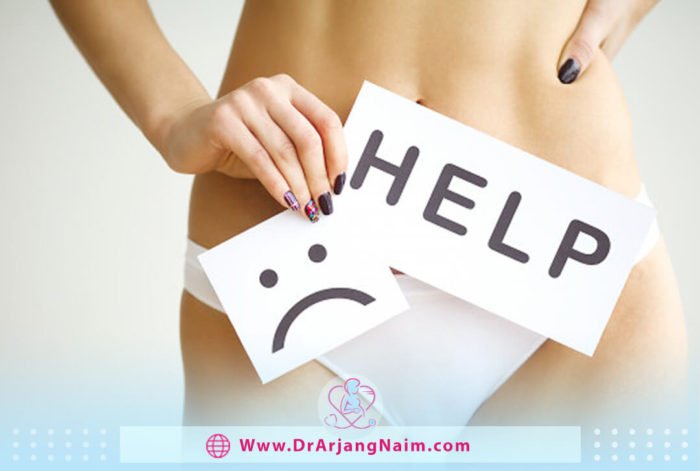Vaginal Atrophy, also called atrophic vaginitis, is when the vaginal lining becomes dry and thin. These symptoms lead to itching, burning, and pain during sex. The disease also includes urinary tract problems such as urinary tract infections and frequent urination. Vaginal refers to the vagina, while atrophy means diminution or wasting away. The term vaginal atrophy has recently been replaced by a newer word, genitourinary syndrome of menopause (GSM). The new term describes the vagina and helps with urinary symptoms, which can be associated with low estrogen effects.
Vaginal atrophy due to a decrease in estrogen often occurs during menopause. Of course, it can also occur in younger women when their estrogen levels are affected. Hormones are produced, stored, and secreted by the endocrine system, a network of glands and organs. Women need estrogen for health, especially in their fertile years. Menopause is around the age of 50. The ovaries produce less hormone, and the period stops. There are many unpleasant symptoms for women during this time, including vaginal dryness and other symptoms that may indicate vaginal atrophy.
Symptoms
While genitourinary syndrome of menopause is common, only 20 to 25 percent of women with symptoms get medical attention. In some women, the symptoms occur during menopause or in the years leading up to menopause. In other women, the symptoms may never appear. Genitourinary syndrome of menopause signs and symptoms may include:
- Vaginal dryness
- Vaginal burning
- Vaginal discharge
- Genital itching
- Burning with urination
- Light bleeding after intercourse
- Discomfort with intercourse
- Urgency with urination
- Frequent urination
- Recurrent urinary tract infections
- Urinary incontinence
- Decreased vaginal lubrication during sexual activity
- Shortening and tightening of the vaginal canal
- Feeling of pressure

Causes
A decrease in estrogen production causes atrophic vaginitis. Less estrogen makes vaginal tissue thinner, drier, more elastic, and more fragile. Causes of vaginal atrophy include:
- Breastfeeding
- Anti-estrogen medications
- Some birth control pills
- Surgery to remove both ovaries
- Chemotherapy
- After menopause
- Pelvic radiation therapy
- Hormone treatment
Who is at risk of getting vaginal atrophy?
Menopausal women over 50 are more likely to experience vaginal atrophy. Other factors that increase the risk of vaginal atrophy include:
- Lack of sexual intercourse
- Decreased ovarian functioning due to chemotherapy or radiation
- Immune disorders
- Smoking
- Breastfeeding
- Anti-estrogen medications
- Some birth control pills
- Surgery to remove both ovaries
- Pelvic radiation therapy
- Hormone treatment
How common is atrophic vaginitis?
At least half of menopausal women suffer from the signs and symptoms of genitourinary syndrome of menopause.
Diagnosing vaginal atrophy
See a doctor immediately if sexual intercourse is painful, even with lubrication. Symptoms such as vaginal bleeding, discharge, burning, or pain need to see a gynecologist. The gynecologist asks about health records such as the date of the last period or cancer in the past and about consumables such as perfumes, soaps, bath products, deodorants, lubricants, and spermicides that can cause allergies. The doctor will also examine pelvic organs to check for the following:
- The pale, smooth, shiny vaginal lining
- Loss of elasticity
- Sparse pubic hair
- Smooth, thin external genitalia
- Stretching of uterine support tissue
- Pelvic organ prolapse
The doctor might order the following tests:
- Pelvic examination
- Vaginal smear test
- Vaginal acidity test
- Blood test
- Urine test
Treatment of vaginal atrophy
With treatment, a woman can improve vaginal health and quality of life. Treatment can focus on the symptoms or the underlying cause. Over-the-counter moisturizers or water-based lubricants can help treat dryness. If the symptoms are severe, a doctor may recommend estrogen replacement therapy. Estrogen improves vaginal elasticity and natural moisture. Estrogen can be taken topically or orally.
Topical estrogen
Taking estrogen through the skin limits the amount of estrogen that enters the bloodstream. Topical estrogen comes in many forms, including:
- A vaginal estrogen ring, like Estring. The Estring is a soft, flexible ring that is inserted into the upper part of the vagina by the person or doctor. It releases a fixed dose of estrogen and only needs to be replaced every three months.
- Estrogen rings are preparations with a higher estrogen dose and may increase a woman’s risk of endometrial cancer.
- A vaginal estrogen cream such as Premarin or Estrace. These drugs are inserted into the vagina before going to bed with an applicator. The doctor may prescribe the cream daily for a few weeks, then reduce the dose to two or three times a week.
- A vaginal estrogen pill such as Vagifem is inserted into the vagina using a disposable applicator. It is usually given as a daily dose, which is later reduced to once or twice a week.
Complications of systemic estrogen treatment
Systemic estrogen therapy can cause some side effects, including:
- Breast tenderness
- Headaches
- Nausea
- Indigestion
- Vaginal bleeding
- Stomach pain
In general, the benefits of using systemic estrogen usually outweigh the risks.
Oral estrogen
During menopause, oral estrogen is often used to treat vaginal dryness and hot flashes. But long-term use increases the risk of some cancers. Oral estrogen is not usually prescribed for people who have had cancer before. In addition to estrogen, progesterone may be given as a pill or patch.
Women taking progesterone and estrogen may bleed some after menopause. While the risk of cancer is low in women who take both progesterone and estrogen, it is important to see a gynecologist if you have postmenopausal bleeding.
Prevention
In addition to taking medication, making lifestyle changes can reduce the symptoms of vaginal atrophy. Wearing cotton underwear and loose-fitting clothing can improve the symptoms. Loose cotton clothing improves air circulation around the genitals, thus reducing the chances of bacteria growing.
A woman with atrophic vaginitis can have pain during sex. However, staying sexually active increases blood circulation in the vagina and stimulates natural moisture. Sexual activity does not affect estrogen levels, but as blood circulation improves, the sexual organs stay healthy for longer. Allowing time for sexual arousal can make sex easier. Vitamin E oil can also be used as a lubricant. There is also some evidence that vitamin D increases vaginal moisture. Vitamin D also helps the body absorb calcium. This helps reduce or prevent bone loss after menopause, especially with regular exercise.
Complications
Genitourinary syndrome of menopause increases the risk of:
- Vaginal infections: Changes in the acidic balance of the vagina increase the risk of vaginal infection.
- Urinary problems: GSM-related urinary changes can contribute to urinary problems. Women may experience frequent or urgent urination or burning with urination. Some women are more likely to have a urinary tract infection or urine leakage.

Natural remedies for vaginal atrophy
In addition to chemical treatments, there are natural treatments to improve vaginal atrophy, including:
- Exercise: Regular exercise and physical activity help balance hormones, thus reducing atrophic vaginitis.
- Keeping the body hydrated: Keeping the body hydrated can help maintain moisture levels.
- Natural lubricants: Some natural lubricants may help soothe and lubricate the genital area, such as jojoba, coconut oil, aloe vera, and vitamin E suppositories.
- Probiotics: Probiotics are bacteria that positively affect the human body. Probiotics may help relieve the symptoms of vaginal atrophy.
The effect of breast cancer history on the treatment
A woman with a history of breast cancer should consult her doctor about any potential treatment. Estrogen can be harmful to women with a history of breast cancer. For this reason, your doctor will usually not recommend systemic estrogen therapy to a woman who has had breast cancer. The following are the best choices for women with vaginal atrophy who have breast cancer:
- Non-hormonal treatments, such as moisturizers and lubricants
- If the symptoms are not treated, low-dose vaginal estrogen
The bottom line
Vaginal atrophy is the thinning of the vaginal walls caused by decreased estrogen production. This often happens after menopause. Estrogen, produced by the ovaries, plays a vital role in lubricating and keeping vaginal tissue healthy. When estrogen levels are low, vaginal tissue becomes dry and brittle, making the vagina more prone to inflammation and infection. If the symptoms of atrophic vaginitis are bothersome, the woman must see a gynecologist. Arjang Naim MD thoroughly reviews the patient’s condition and suggests the best treatment strategy with the least side effects.
Additional questions
- What are the three main functions of the endocrine system?
- Makes hormones for mood, development, and growth
- Sends hormones into your bloodstream
- Regulates the release of hormones
- What is the most common cause of frequent urination?
Urinary tract infections (UTIs), in particular, are the most common cause of urinary frequency. During a UTI, a foreign infection enters the body and causes inflammation in the urinary system.
- What is pelvic radiotherapy?
Radiotherapy treats cancer by using high-energy rays to destroy cancer cells. The use of radiotherapy to treat cancer in the pelvis is called pelvic radiotherapy.
- What does vulvar atrophy look like?
The vulva and vagina may appear pale, shiny, and dry. If there is inflammation, they may appear red or pale with petechiae. Vaginal veins disappear, and the cervix may flush with the vaginal wall. Shortening and narrowing of the vagina usually occur. A thin, yellow vaginal discharge may be observed.
- What is atrophic bleeding?
This is a condition in which the vaginal lining becomes drier and thinner due to a lack of estrogen. Burning, itching, spotting, pain with sexual intercourse, frequent urination, and urinary tract infections are common symptoms.
References
https://www.mayoclinic.org/diseases-conditions/vaginal-atrophy/diagnosis-treatment/drc-20352294
https://www.webmd.com/menopause/vaginal-atrophy#1
https://my.clevelandclinic.org/health/diseases/15500-vaginal-atrophy/living-with
https://www.healthline.com/health/atrophic-vaginitis#_noHeaderPrefixedContent
https://www.health.harvard.edu/a_to_z/vaginal-atrophy-atrophic-vaginitis-a-to-z
https://www.medicalnewstoday.com/articles/155651#signs-and-symptoms




